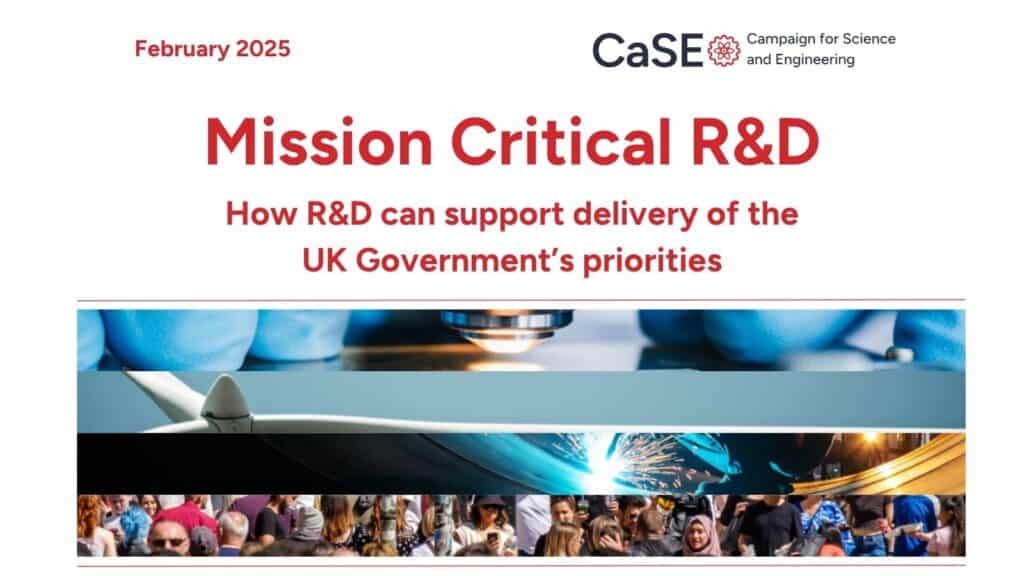CaSE’s evidence submitted to the House of Commons Science and Technology Committee’s inquiry into the 2010 Spending Review
Spending Review 2010: S&T inquiry
13 May 2011
The House of Commons Science & Technology Select Committee is undertaking an inquiry into the Spending Review 2010, and its impact upon the science and engineering base. This is the evidence submitted by CaSE, which was originally published here.
1. The Campaign for Science & Engineering (CaSE) is a membership organisation aiming to improve the scientific and engineering health of the UK. CaSE works to ensure that science and engineering are high on the political and media agenda, and that the UK has world-leading research and education, skilled and responsible scientists and engineers, and successful innovative business. It is funded by around 750 individual members and 100 organisations including industries, universities, learned and professional organisations, and research charities.
Section Headings:
Summary
The Science Budget
Capital Expenditure
Old Science Budget vs New Science Budget
Context – international and domestic
Diversity
Education
Monitoring
Conclusion
2. The 2010 Spending Review was initially perceived as a better-than-expected result for science and engineering, with the sector having escaped the worst of the cuts to public spending necessitated by the 2010 Emergency Budget. However, in the months since the spending review it has become clear that the sector is coming under considerable strain from a variety of angles. We argue that these strains could significantly damage the UK’s ability to be a world-leading scientific and engineering nation in both the short- and long-term.
3. On October 20th 2010 it was announced that the Science Budget was to be £4.6bn for every year of the spending review period until 2014-15 – in effect, a ‘cash freeze’.
4. This freeze was highlighted in the Executive Summary of the Spending Review as a step to improve economic growth and rebalance the economy. It was also leaked to the media (specificallyThe Times and the BBC) on the evening of the 19th October, such that it featured prominently in the media that evening and the following morning, alongside speculation around the cuts that were being made elsewhere in public spending.
5. The cash freeze was widely referred to as translating into an approximately 10% cut by 2014-15 in the Science Budget. However, taking the Office for Budget Responsibility’s inflation estimates, the Science Budget will actually be 14.4% lower in 2014-15 than in 2010-11 – and the settlement could be further eroded by increases in inflation.
6. There is also a question over whether inflation in science and engineering is higher than standard Consumer Price Index. For instance, the US experienced growth in the Gross Domestic Product price index (a broad measure of inflation) of 0.8% in 2010, while the US Government’s own estimate of growth in the Biomedical Research and Development Price Index (BRDPI) was over three times as high, at 2.8%. Few reliable data exist on a similar phenomenon in the UK, but if costs in science and engineering do inflate more rapidly than costs elsewhere, the overall impact on the UK’s research base by 2014-2015 could be real terms cuts still greater than the 14.4% estimate.
7. The continuation of the ‘ring-fence’ around the £4.6bn Science Budget was also announced as part of the Spending Review settlement. This was extremely welcome, as it protects the Science Budget from being raided for other public spending concerns, and also ensures that any savings within the Science Budget can be reinvested in it.
8. The budget for capital expenditure on science and engineering facilities was not announced as part of the spending review. It was later declared that capital expenditure on research would fall by nearly 46% (£1.9bn) over the four years of the spending review; this capital funding is delivered through the Research Councils, the Higher Education Funding Council for England (HEFCE) and other streams to Higher Education Institutions across the UK. The 46% cut compares to a 43% overall reduction in capital expenditure of the Department for Business Innovation and Skills (BIS), so research capital is taking more than its fair share of reductions within the department.
9. This cut is ameliorated slightly by £220m of funding for UK Centre for Medical Research and Innovation now coming from the Department for Health (DH), rather than the Medical Research Council. However, it is not clear whether this is in addition to, or subtracted from, what the DH would have otherwise received for its research budget.
10. The impact of nearly halving the capital available for research may be more than initially apparent. Much capital spending is accounted for by expenditure that is not typically perceived of as capital – including staff and equipment costs for maintaining and upgrading equipment – and much that cannot be realistically cut back without significant cost. Equipment costing relatively small amounts of money and essential for general lab work can be categorised as capital spending, depending on which Research Council is the funder. The proportion of research money available for new equipment and facilities is therefore much less than 100% (and will vary between different Research Councils). Therefore the impact of the capital cuts will be to reduce the UK’s capacity to invest in cutting-edge science and engineering projects by more than 50% (as well as seriously affecting ongoing research).
11. It should be noted that a shortage of funding also means that past capital investment is not being fully taken advantage of. For instance, both the ISIS light source and Central Laser Facility are currently running below optimum capacity, even though the marginal cost of extra operating days at these facilities is very low compared to the cost of the facility itself.
12. On 23rd March 2011, Chancellor Osborne announced £100m of new capital investment in science facilities around the UK. This was extremely welcome, especially at a time of austerity, and will help certain facilities attain world-leading status in their fields. However, the extra capital did nothing to remedy the enormous cut in standard operational capital budgets created by the spending review. To put it in perspective, it was also matched the sum of money (£100m) set aside on the same day for repairing the nation’s potholes.
13. One aspect of the Science Budget allocations which is not yet clear is whether Research Councils will have the flexibility to transfer funds from their resource allocation into capital, in order to purchase replacement equipment or pay for maintenance. This should be clarified.
14. Prior to the Spending Review 2010, the ‘Science Budget’ consisted primarily of the resource allocation and the capital allocation for the seven Research Councils, but excluded money distributed via HEFCE. The coalition government has now redefined the term by excluding all capital expenditure, but including the resource allocation for HEFCE and all spending on the new UK Space Agency.
15. It is clear that if the government had used the established definition of the ‘Science Budget’, they would not have been able to claim they had ‘frozen’ it on the morning of the 20th October. The true impact of the cuts was not clear until the Science Budget Allocations in late December 2010. The new definition also means that capital spending on research is no longer protected by the ring-fence around the Science Budget, making the meagre allocation even more precarious.
16. There is no doubt that the settlement for science and engineering in the UK is better than had been thought likely. The community had been fearing cuts of up to 20% or 30%, in part due to the contents of the Business Secretary’s speech at Queen Mary University of London in September 2010, which focused on doing ‘more with less’. In the end, science and engineering escaped the severe cuts which have affected other areas of public spending.
17. However, the UK science and engineering’s success is determined more by how competitive we are internationally, not by how BIS fares against other Whitehall departments. In the international context, the downsized Science Budget looks less healthy.
18. Germany, a nation similar to the UK in many ways, has been forced to institute its own austerity budget as a result of the banking crisis. Overall federal expenditure is being cut from €319.5bn last year to €307.4bn this year, yet funding at the Ministry of Education and Research is rising by 7.2%, which includes €327m for university research excellence, and support for research and development (R&D) at the Federal Economics Ministry is also increasing. This is congruent with Chancellor Angela Merkel’s past argument that “the prosperity of a country such as Germany, with its scarce mineral resources, must be sought through investment in research, education and science, and this to a disproportionate degree.”
19. The Chinese equivalent of the UK Research Councils is the National Natural Sciences Foundation of China (NSFC), which is that nation’s main agency for funding competitive, peer-reviewed grants. China’s 2011 Budget announced that the NSFC will see a 17% increase this year, which will mean its budget will have doubled from 2009 to 2011.
20. It is clear that the nations with which the UK will need to collaborate with and compete against are using investment in R&D, and the knowledge economy, to stimulate their economy today and also to plan for the future. It could be argued that the higher priority Germany had previously given to research, development, and manufacturing in its economy is partly responsible for its greater resilience during the financial crash. In 2007 the proportion of the UK’s GDP spent on R&D (the ‘knowledge intensity’ of the economy) was 1.8%, whereas the comparable figure for Germany was 50% higher, at 2.5%. This greater resilience has put Germany in a strong position to invest more in science and engineering, leaving the UK at an even greater competitive disadvantage as we retrench our own spending.
21. The Science Budget is not the only source of funding for R&D in the UK. For instance, the Regional Development Agencies (RDAs) spent £440m supporting R&D throughout the UK in 2007/8. The RDAs have largely been abolished, the expertise of their staff lost, and their assets are being sold, with their function replaced by the Regional Growth Fund (RGF).
22. The RGF consists of £1.4bn available from 2011-2014, which corresponds to an average of £400m per year. Therefore, even in the unlikely event of 100% of the new RGF being used to support research and development, it would not adequately replace the RDAs. The new Technology Innovation Centres, while potentially being an important step forward for innovation in science and engineering, only provide approximately £50m per year. On a related note, it is not yet clear at what level the Technology Strategy Board will be funded on an ongoing basis.
23. One of the notable casualties of the Science Budget allocations following the Spending Review has been the cessation of funding for the UK Resource Centre for Women in Science, Engineering and Technology (UKRC for Women in SET). This is despite the continuing huge disparities between the genders in science and engineering – for instance, only 30% of women with degrees in science, technology, engineering or mathematics (STEM) are employed in the STEM sector compared with 50% of men. This disparity represents a loss to the individuals involved, but there is also a huge economic cost, as significant resources have gone into training these individuals, who then do not get the opportunity to use their skills, at the same time that there is high demand for those skills among employers.
24. BIS has said they do not want to neglect the diversity agenda, but to ‘mainstream and embed equality and diversity in all [their] Science and Society programmes’. CaSE would welcome a commitment to mainstreaming, as there are diversity problems in areas other than gender. For instance, disabled people make up only 3.8% of the STEM workforce, compared to 5.9% of the total workforce, and CaSE is working with partners in the sector to improve resources for disabled scientists and engineers. Coming from certain ethnic minority or socioeconomic backgrounds also affects participation in STEM. For example, pupils from independent schools are considerably over-represented in science and engineering A-levels compared to their peers in comprehensive schools.
25. However we are still awaiting a clear strategy from BIS showing how they plan to ‘mainstream and embed’ the diversity agenda in their work. We call for the Department to consider and publish a strategy which outlines the issues they believe are most important to tackle in the coming years, and how they intend to work with the community to do so. The need for this has become more pressing with the publication of the UK Research Council delivery plan over the next four years, during which it will cut back its spending on careers and diversity by 73% to £1m in 2014-15. Furthermore, the Government has put the Equality Act 2010 up for review on its website that urges the public to fight back and cut red tape.
26. As a result of the spending review, the Department for Education has informed the Training and Development Agency that it will no longer be funding ‘golden hellos’ for new science and maths teachers, based on a ‘value for money’ decision. CaSE has asked for this ‘value for money’ analysis to be published, but this request has been ignored. The nation already has a severe shortage of teachers with the relevant background in physics, chemistry and maths, with an estimated shortage of 4,000 physics teachers alone. The situation may deteriorate further if funding is stopped for teacher training for graduates with less than a 2:2 degree, of which there are unusually high proportion in shortage subjects, as is proposed in the current Education Bill. If teacher shortages are exacerbated by decisions made by the Department for Education, it could have huge impacts on our national research, development, and innovation capabilities.
27. Each year BIS publishes SET Statistics – science, engineering, and technology indicators. These provide a historical analysis of government and other spending in science and engineering in the UK, and are a vital tool in assessing and evaluating current activity and targets. The most recent indicators, for 2010 and published earlier this year, have been significantly scaled back in terms of their scope and detail. No reason for this change has been given. We would ask the Committee to consider why it has occurred and what the implications will be for monitoring past and future science, engineering and innovation performance, and for policy formulation.
28. Socio-economic and demographic change in the UK, Europe, and the rest of the world means that this country can no longer expect to be competitive in low- and medium-skills sectors over the coming decades. We will not have the supply of cheap labour or natural resources to be successful in these areas.
29. This necessitates planning for the UK to be a more knowledge-intensive economy, with a higher proportion of our output and employment deriving from high-skills sectors. This is the model which competitor nations such as Germany, Japan, South Korea, and Finland are pursuing.
30. Other countries are pursuing this path because of the enormous benefits that research investment can bring. Benefits include the spinning out of new ideas into products that can be commercialised to build economic growth or directly benefit society, for example, through health gains. Public investment in R&D also helps generate private investment from research charities and from industry. Note that the UK receives an unusually high proportion of its R&D funds from foreign owned firms (17%) which may be more flexible in the location of their spending than UK-based companies (and therefore more responsive to international comparisons).
31. The UK spent hundreds of billions of pounds during the financial crisis to rescue the nation’s finance industry, which was on the verge of collapsing. It has become clear that the UK’s economy had become overly reliant on financial services, and that we need to ‘rebalance’ the economy.
32. We ask the Committee to consider whether the Spending Review 2010 showed significant signs of a commitment towards such rebalancing. Science and engineering are crucial to the UK’s economic future – is the support that they are given comparable to the efforts that were made to maintain the economic status quo during the financial crisis?
33. We also note that decisions about investment in science and engineering (whether of a financial nature, or an investment of intellect and careers) are made with a view to returns over decades, not the four or five years typically used for political decision-making. For the UK to be successful in science and engineering over the long-term, it must make a long-term commitment to the science and engineering.
Declaration of Interests
The UKRC for Women in SET is a member of CaSE.
Related resources

CaSE analysis of Government Expenditure on R&D (GovERD) statistics for 2023.

CaSE takes a look at the details of the DSIT 2025/26 spending allocations, including UKRI.

Analysis and highlights from CaSE’s research into public attitudes towards R&D and the Government’s missions.

This report sets out evidence on the integral role of R&D in driving progress on the UK Government’s missions.